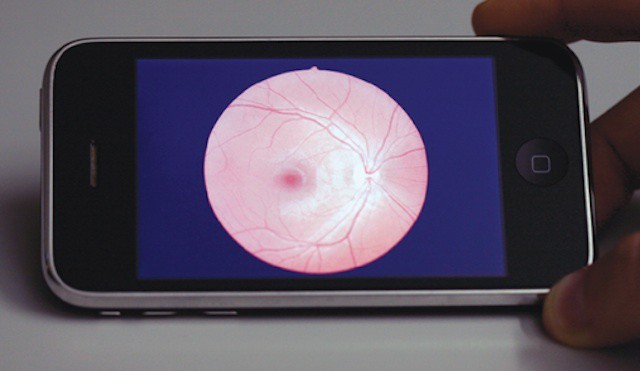The uses for Apple’s iPhone and iPad in healthcare seem to be growing by leaps and bounds. The latest field of medicine to take note of the power that iOS devices offer doctors and healthcare providers is ophthalmology. A new study shows that the iPhone may make a better tool when reviewing certain types of ophthalmology images that a standard desktop PC workstation.
What’s truly amazing is that the iPhone used in the study was a four-year-old iPhone 3G.
The study was reported in the July issue of The Archives of Ophthalmology (part of the Journal of the American Medical Association network) and was performed by researchers at Atlanta’s Emory University. the research team included specialists in the fields of ophthalmology, neurology, emergency and neurological surgery.
In testing the iPhone 3G as a clinical tool for diagnosing vision problems, the researchers specifically focused on settings like a hospital emergency room where traditional ophthalmology may not be available.
The team used a collection of 350 images from patients with a range of specific symptoms that could indicate eye injuries or conditions including headache, focal neurologic deficit, visual changes, and high diastolic blood pressure. When rating images, reviewers assigned higher ratings to the iPhone on average than those assigned to a PC with a 19″ LCD display – the opposite of the expected results.
We expected equal- or lower-quality ratings for photographs displayed on the iPhone compared with the desktop computer, but instead we found that reviewers assigned higher ratings on average for photographs displayed on the iPhone. Because the magnitude of this difference was similar for both reviewers and no bias in the other ratings was observed, we believe this occurred because the advantages of the iPhone’s display (eg, higher dot pitch and brightness) outweighed its disadvantages (eg, lower resolution and smaller screen area).
One has to wonder at what the results might have been if an iPhone 4/4S or the new iPad were used as they have much higher resolution and image quality due to Apple’s retina display technology (aside from the obvious pun about looking at a retina on a retina display).
While the findings were impressive and the team suggested that further research should be done to build on them, the researchers point out that this study is not suggesting that an iPhone can or should take the place of existing ophthalmology tools or screening procedures. They do suggest, however, that the iPhone may have a place in emergency departments when it comes to certain vision conditions as well as in the growing field of telemedicine, which uses various technologies (including Apple’s FaceTime) to enable remote consultations and diagnostic/treatment services.
Source: The Archives of Ophthalmology
Via: MobiHealthNews
Image: The Archives of Ophthalmology


